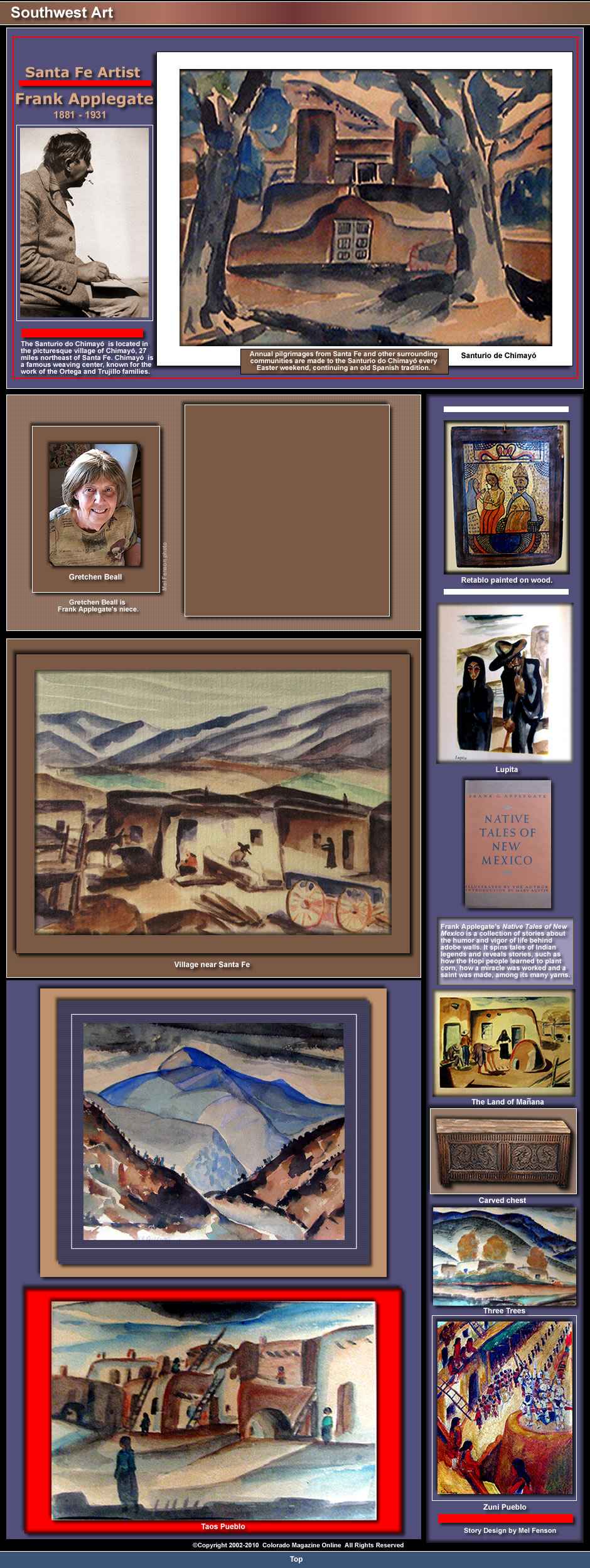

Frank
Applegate: Artist and Citizen
By Gretchen
Beall
At
any stage of his somewhat shortened life, Frank was active and noticed. It
wasn’t just his height – although he was a head taller than any
of his five brothers and three sisters at about 6 feet 4 inches. He took an
extraordinary interest in his surroundings wherever he was, and he had both
a great capacity for work and an immense sense of humor.
Frank attended the University of Illinois on a scholarship, where he majored
in architecture. He played football there, so he could eat at the training
table! After graduation, he set out for France to study at the Academie Julian
and absorb European culture. He toured France on foot and also traveled to
Rome. On returning home, he taught at The School of Industrial Arts in Trenton,
New Jersey. He married Alta Chenoweth, who was a librarian in Atlanta and
a family friend in the summer of 1908.
Modeled figures in clay became Frank’s artistic medium, while he was
in New Jersey. He spent his summers in New England, exploring new sources
of clay, also painting and making friends with already distinguished artists.
Much of his work reflected what he had experienced in Paris as well as what
he had seen in the cities of New York and New Orleans. He showed his work
at various galleries in Philadelphia and New York and received positive reviews
in the New York Times. The Applegate’s became three with the birth of
their daughter, Betty. While living on the East coast, they built a new home,
which he designed, along the Pennsylvania Canal in Morrisville, Pennsylvania.
In summer of 1920, at the age of 39, Frank and his family packed a few belongings
and themselves into their Model T Ford, and set off for California to look
for new clay. With no super highways, it took a week to cross Kansas. Making
their way into New Mexico, they stopped to camp in the highlands above Santa
Fe, fell in love with the area, and decided to stay!
The very air and light in Santa Fe seem to call for artistic activities. Frank
had worked in many roles, all of which were reflected in both his architecture
and his artwork. In Santa Fe, he discovered the beauty of Native American
and Hispanic cultures and began to paint watercolor images of their environment
and lifestyles. He also worked in oil.
He
built a “mud” brick house for his family at the top of Camino
del Monte Sol road in Santa Fe’s historic district. In 1926, he purchased
the historic four room de la Pena home, which dated to 1845, and had been
occupied by members of the de la Pena family for 80 years. Frank added on
to the house but retained the original style as much as possible. Today, the
house is occupied by Gerald Peters, a prominent Santa Fe builder and art dealer.
Frank took a lively and serious interest in the people living in and near
Santa Fe. There was a large Mexican population in the area, and Frank and
artist friends opened a shop to sell art and crafts created by Mexican artists.
Frank also encouraged local Indians to bring their arts and crafts to Santa
Fe to sell. Frank experimented with Mexican art styles, carving a wood chest
and creating santos and retablos.
Santa Fe and Taos both boasted artists’ groups, which included many
accomplished painters. They would go out in the countryside and paint together.
They also cooperated in marketing their works in Chicago, several galleries
in New York and in California. Many artists spent summers in Santa Fe, including
Andrew Dasburg, John Sloan, Randall Davey, Theodore Van Sloelen, and Walter
Mruk. The first three of these were already well established in Eastern U.S.
Artists working together there also included B. J. O. Norfeldt, Walter Henderson,
Joe Bakos and others. In fact a traveling show of many of their works started
out in Chicago and traveled to many cities, ending in New York. The New Mexico
painters often sent new paintings to join the show along the way.
Frank’s interests were broader still. His publication of Indian
Stories from the Pueblos was followed by Native Tales of New Mexico,
published after his death. The first publication was comprised of Indian art
and his own paintings were published in the latter publication. Multi-talented,
Frank also began acting in a local theater group. He was also active in protests
about billboards being built along the highways, because they detracted from
the beauty of the country side.
It was after a rehearsal of a production of A Monkey’s Paw,
a popular one-act drama of the time, that Frank returned home, stopping to
rest in the downstairs living room. His wife was upstairs in their bedroom
and she heard his loud, heavy breathing. He died before she could get help.
He was just 50 years old.
Today, Applegate’s works may be seen in the Gerald Peters’ gallery
and other Santa Fe galleries and restaurants, and in private collections.
His efforts, along with other artists of the time, to preserve Indian and
Mexican arts, along with his paintings and his preservation efforts are the
heritage he left to the world.
 |
|